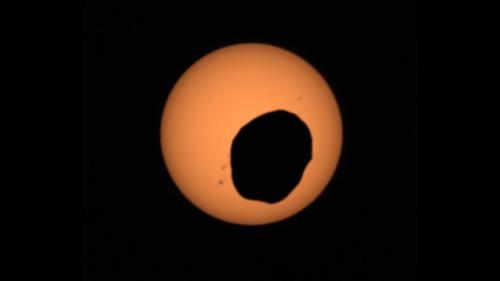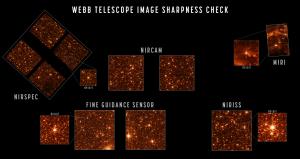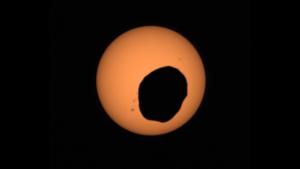Celebration of Space - April 29, 2022

A solar eclipse happened on Mars last week when Phobos, Mars' largest moon passed in front of the Sun. Credit: NASA/JPL-Caltech/ASU/MSSS/SSI
Tomorrow, Saturday, April 30, 2022 at 4:31 pm, the April New Moon will occur. This is the time of the lunar month that the Moon reaches conjunction, which is when the Moon orbits in between Earth and the Sun. It is an alignment of the three objects, which is what creates the Spring Tide (exaggerated ocean tides during the New and Full lunar phases). Since the Moon is in between Earth and the Sun, the side of the Moon that is in direct sunlight is the opposite side of the Moon that faces Earth. Coupled with the daytime placement of the Moon, meaning that the Moon will rise and set with the Sun, the Moon is not easily visible during the new phase. Though the New Moon brings the best night of the 29.5 day phase cycle for stargazers and astro photographers because the sky will be super dark for the entire nighttime period. As for the distance of the Moon during tomorrow’s New Moon, the Moon will be at a distance of around 244,200 miles distant, which is right in between perigee (closest) and apogee (furthest). So no super / micro anything.
Tomorrow, Saturday, April 30, 2022, starting at 10:00 am, and going until 2:00 pm, the Town of Charlestown will put on its annual Earth-Fest celebration in Ninigret Park – home to Frosty Drew Observatory and Science Center. The theme of the day – Earth, and how awesome of a place it is. Outdoor exhibits will be set up by dozens of organizations, including Frosty Drew Observatory and Science Center. There will be bouncy houses, balloon animal making, live music, and some food, among others. Frosty Drew will have our solar telescope(s) set up for solar viewing, and may have the Observatory and Science Center open for tours, including tours of our new telescope and possibly Venus spotting if we can do it safely. The forecast for tomorrow looks fantastic, and Ninigret Park is a beautiful daytime destination with tons of family and kid friendly stuff to do. So stop in, set up a lovely picnic, and celebrate springtime in the park tomorrow.
On the James Webb Space Telescope front, things couldn’t be better! This past week the final alignment operations of the large 21.3 foot primary mirror were completed, which required applying mirror alignment to all science instruments on board. The resulting image shows the level of precision that each detector can accomplish. Check out the image. The next step, which is the final step, is the commissioning of all science instrumentation. This will include testing each device with filters, spectrographs, and other light modifying accessories. The commissioning phase will take approximately 2 months to complete, at which time the JWST will be fully operational and ready to begin actual data collection. So exciting! Configuration engineers persist in their evaluations that the observatory is functioning better than anybody had expected. Which is a stark difference to the initial configurations of the Hubble Space Telescope, which had to undergo several re-configuring missions via the shuttle to get it working properly. Take a few minutes to dig into the image listed above, then stop in on the James Webb Space Telescope page and catch up on the journey this fabulous observatory has had!
With the coming total lunar eclipse on Sunday – Monday, May 15-16, 2022 (https://frostydrew.org/Lunar-Eclipse), the buzz is starting to kick in and anticipations are mounting for a spectacular night. Though Earth isn’t the only place where eclipses happen. Any planet that has moons can potentially offer views of a solar and lunar eclipse. One such event happened last week on Mars, when Phobos, the largest of Mars’ two moons (Deimos is the smaller one), passed in between the Sun and Mars, while on the ecliptic, which is the path the Sun takes across the sky. Fortunately, the Mars Perseverance rover happened to be checking out the Sun that day and spotted the beautiful solar eclipse. Now Photos, and Deimos are not like Earth’s Moon, which is very large for Earth. Mars’ moons are more asteroid-like and do not completely block the Sun during an eclipse. Take a moment or two and watch the eclipse as seen from the Perseverance rover on Mars. Fantastic!
Tomorrow morning, Saturday, April 30, 2022 and again on Sunday morning, May 1, 2022, the ongoing conjunction of the planets in the morning sky will again hit a special moment. This time it involves Jupiter and Venus, which will be visibly passing each other in our morning predawn sky. We’re talking super close, like 0.25° visibly apart. That is spectacularly close, and well worth a morning trek out to catch a view! The conjunction will hit the East horizon at 4:15 am, and will rise towards the SE over the next hour before sunlight overtakes the view. You will need to be somewhere with a good view of the E → SE horizon to see it. But in RI, with so many coastal locations, this is a cake walk. Be there for 4:15 am and look to the ESE. Venus and Jupiter will be so close that, depending on the quality of your vision, may look like one large star. If you catch a view, let us know by replying to this email. If you catch a photo, post it on our Facebook or email it to astronomer@frostydrew.org and we will share it on our social media.
This coming Sunday, May 1, 2022 is May Day, which is an astronomical holiday. One of the four Cross-Quarter days of the year, May Day marks the approximate midpoint between the Vernal Equinox and the Summer Solstice. Cross-quarter days are the days that fall in between the Equinoxes and Solstices. The first cross-quarter day of the year is Groundhog Day, the second is May Day, the third is Lammas in August, and the final is Halloween. Even though it has been a bit chilly these past few days, we are now half way through the spring season and closing in on the start of summer.
Last week we published an error. Well I published an error. I stated that the Eta Aquariid Meteor shower will peak on Monday, May 5, 2022. Well that date does not exist. The correct date to view the Eta Aquariid Meteor Shower peak will be on Thursday, May 5, 2022 during the morning hours after 2:00 am. Hey, a day without a mistake is a day without learning. Thanks to all who wrote in to let me know. I’m glad you are reading!
- Author:
- Scott MacNeill
- Entry Date:
- Apr 29, 2022
- Published Under:
- Scott MacNeill's Columns





